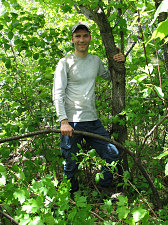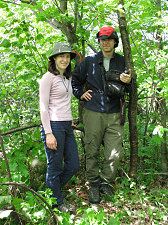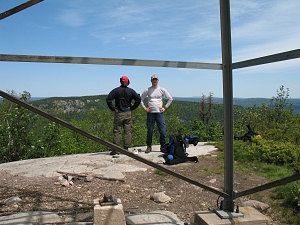The easy-to-follow path led up past a couple of small and pretty lakes and across a few boggy and wet areas - one of which had logs to assist in crossing, one of which had no logs (and was quite deep), and one of which was across a beaver dam (not quite so deep but still wet). After all of this, a final climb of about 500 vertical feet brought us to within sight of the summit's firetower. Ontario's Highpoint was within our grasp!!

courtesy RHanel
We reached the top a little over six hours after starting out. There is a small open area near the tower, affording expansive views to the northeast and southwest. The tower itself, marked as closed for climbing, looks to be in good shape. Roland and I climbed a little to get a few snaps of the wider region.
I'd heard on the 'net that possibly, just possibly, another spot further northwest of the tower might actually be a bit higher. The thought had nagged at me all day, and now that we were at the top, it seemed foolhardy not to set foot over on the spot _just in case_. We could sort of see a very slight hump to the northwest through the trees - it was impossible to tell if it was higher or not.
So, it was time for yet more bushwhacking. Except that up here on the summit the vegetation was a bit more tangled, and so the going was slower. We bushwacked about 250 metres west-northwest to the slight hump. Although I closely compared the elevation reading between the tower and here, the results were inconclusive. It could actually be a metre or two higher, but we couldn't be sure. So, we wrapped a bit of flagging around the highest tree, just in case we'd just become the first real summiters of Ishpatina, and headed back to the fire tower.

courtesy RHanel

courtesy RHanel
Roland at alternate summit
The summit of Ishpatina Ridge - in fact, throughout most of the hike to the summit - one gets a real sense of remoteness and wilderness. Unlike most of the places where I've done my outdoor activities, where there is always some structure, clearing, or road visible and relatively close by, there is absolutely no sign of human activity in any direction, and perhaps even at night there are no distant lights visible. The fact that we hadn't seen another human since the day before added to the sense of remoteness. Canada is a big and wild place, and, once you get north of the southern built-up strip, that's it - except for a few small isolated communities. I think the remoteness is a big part of what made this hike special, even though the terrain wasn't that exciting and the bushwhacking was a pain in the butt.

courtesy RHanel